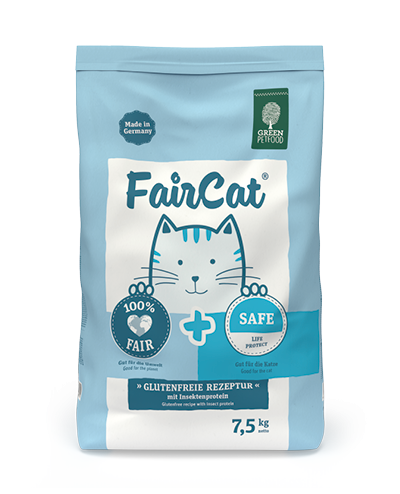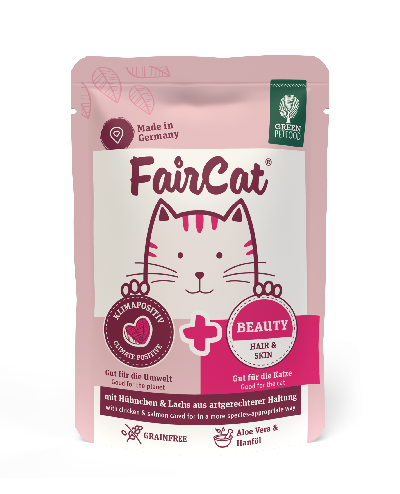Cat toy DIY – easy and homemade
Chasing, lurking and catching – cats have a basic need to practise and live out their hunting skills, to exercise and to keep fit. With suitable DIY cat toys you can help your little tiger in the best way possible - and also act sustainably. Katarina, who has two cats of her own, shows you how to make your own homemade cat toys really easily.

Katarina with Snoopy and Harry
What her little missy loves: gardening, drawing and coffee.
What both cats like: Eating, hunting and nature.
That's why they love Green Petfood: My cats really pounce on the food; they love the taste. For me personally, of course, it's great that it's sustainable and contains very good ingredients.
Purringly happy – thanks to the right occupation
Play releases happiness hormones and this improves the well-being of cats. Cats love to play: they want to learn, discover and explore for themselves. As they are particularly protected by their owners in this phase, they do not have to worry so much about possible dangers in their environment and can simply play.
Indoor cats need to be kept busy, as their time is not taken up with foraging, hunting and strolling to maintain their territory, as is the case with free-roaming cats. They need to be able to burn up their pent-up energy and let off steam. In addition, even with age, they often retain a childlike instinct to play, as they are exposed to fewer dangers and live more sheltered lives than outside. So the time for cat toys often lasts a lifetime.

Playing together is more fun - especially with homemade cat toys
Cats like to play alone, but are also happy to have a young owner as a play partner. This is not only fun but also strengthens the bond between you and your pet. It's best to set aside some time every day for at least one play session, especially if your cat has no outdoor space for playing.
Playing cat-style, however, also needs to be learned – moving a ball or the cat rod just a little bit in front of your kitty just leads to boredom. Cats want to prowl, search, lie in wait, chase, jump, and catch. Cat toys that suddenly disappear behind the chair or around the corner get much more attention from the cat than a stuffed animal that hangs around in front of its eyes without any suspense.

Does my outdoor cat need to be kept busy?
If your cat has the opportunity and the good fortune to spend some time outdoors, with time and age it will tend to lose interest in cat toys. Playing is a distraction and a free-roaming cat instinctively prefers to keep a close eye on its surroundings so as not to become prey itself. It may still be happy to play a game or two when it is in the safety of its own home. So why don't you try out the new cat toy with your outdoor cat?
Fun and action for cats – with our DIY cat toy
It doesn't always have to be a new and expensive shop-bought item. Above all, cat toys don't always have to be electric, like a laser pointer or a remote-controlled mouse. Often, really simple things are enough to challenge your cat's intelligence and keep it sufficiently occupied. The great thing is that in most cases, you will already have most of the materials for a DIY cat toy in your household or can find them outside in nature. Here are a few ideas and suggestions for a playful life with your cat. Let's get started!
Back to nature: Ideas for cat toys made from wood and materials found in nature
Nature offers a whole range of possibilities not only for outdoor cats - even for house cats, branches, wood or pine cones are quickly transformed into an adventure playground. The classic cat toy is certainly the cat fishing rod: tie a piece of natural cord to an old branch or wooden spoon. Attach feathers, a cone or a small cloth bag filled with dried herbs to the cord. Playing with the cat fishing rod requires a human playmate who ensures excitement with lots of movement and hiding. This cat toy offers your cat perfect training for stalking, chasing and capturing its prey. It also gives your cat the chance to practise its dexterity and speed.

With their scents, shapes and moving sounds, acorns, chestnuts, cones and walnuts also stimulate your cat's senses. Cats are also fascinated by the rustling sounds of leaves. Sound effect included! You can use all these things to make a 'fiddle board': Use non-toxic glue and tools to attach things such as wooden balls, rope, bark, cups, wooden dowels, empty toilet paper rolls and egg cartons to a wooden board. Self-adhesive cork or felt pads on the underside of the board protect the floor. With a little skill and ingenuity, your cat will manage to pull the hidden snacks off the board - a tasty game and an exciting activity for your house cat.
Box love: DIY cat toy made from paper or cardboard
Cats and cardboard boxes – a never-ending love story! Leftover cardboard boxes hold great potential for becoming your cat's favourite toy. First of all, you need your own imagination. For example, you can simply cut out holes of different sizes (at least the size of a paw) or entry points in a cardboard box and decorate it with feathers, ping-pong balls, leaves, hay or even corks. Finally, hide a snack or two in between. With this intelligence toy, your cat will really have to rack its brain.
With several cardboard boxes and some non-toxic glue, you'll create a tunnel to crawl through and hide in in no time. With a pair of scissors or a cutter, you can create exits out of the tunnel or even cut windows. In this way, with just a few resources, you can create not only a cat toy, but a whole cat playground!
Apart from the love of cardboard, paper also offers great activity ideas for your cat: An old piece of paper can quickly be turned into a homemade cat toy if you crumple it up into a ball. Your cat will have lots of fun chasing this rolling, rustling object and setting it in motion again. So easy to make yourself - and so popular with house cats! The same applies to the next idea: Classic paper aeroplanes won't survive long once they land in your cat's claws, but they are definitely fun for your pet when they whiz through the air. By the way, this activity is not only fun for your house cat on long days at home!
Tip: Born to win - practice makes perfect
In nature, cats want to hunt successfully and bring home their prey - in short, they want to win. Therefore, you are doing your cat a favour if you let it win often when playing at home. This means that it actually "captures" the cat toy - regardless of whether it's the stuffed bird on the fishing rod or the paper aeroplane. Success also creates positive feelings in your pet.
Toilet paper in stock? Everything for the cat!
Now we have a particularly hot tip for you and your kitty. Why shouldn't your cat also benefit from all the toilet paper that we have at home? The empty paper rolls can be turned into home-made cat toys in no time at all!
If you fix empty toilet paper rolls together with non-toxic glue and fill them with snacks, feathers or acorns, your cat will have lots to discover, feel and capture. You can also turn a single empty toilet roll into a cat rattle in no time at all: Fill it with dry noodles, acorns or small cones, wrap it in paper and knot the sides to form a kind of sweet shape. Toilet paper rolls on a new mission - and time at home used wisely!
And even more DIY ideas for your cat!
How about using the dining room table for a balancing act? To do this, secure a piece of thick rope between two fixed points, such as two table legs, and tighten it. This way your cat can really let off steam and also train its sense of balance, so it's much more than a simple cat toy.

This tip is really sweet: Simply sew small bags out of leftover fabric and fill them with dried herbs such as valerian, catnip, chamomile, basil, lavender or lemon balm.
Alternatively, fill a sock and knot it tightly at the top. Dried herbs can have a very stimulating effect on cats. If your cat responds to the scent, it will chew on the bag, play with it while lying down or roll around on it. The new favourite cat toy is so quick to make! You are bound to find more materials at home that you can use to make toys for your cat. Get creative and put yourself to the test!
Our selection for playful climate saviours!
Caution! Cat toys and their dangers
Naturally, despite all the fun, you should always exercise caution: Small parts, pieces of cloth, strings, woollen balls and the like can be life-threatening for cats. If swallowed, intestinal obstruction, strangulation or suffocation are possible. Supervise your cat when playing and place toys such as fishing rods out of reach afterwards. Toxic materials, sharp edges or plastic bags should never be left near your cat. There should also be enough space to play with the cat toy to ensure that the risk of injury to the cat is not too high.

















